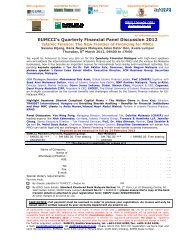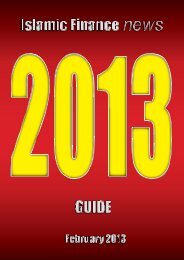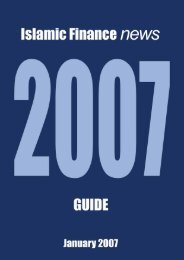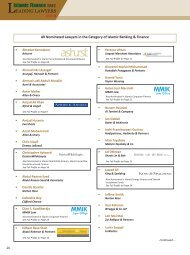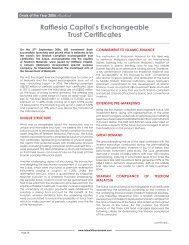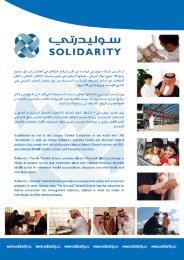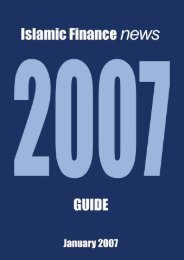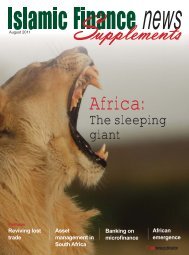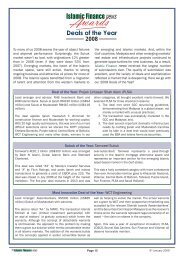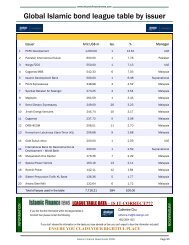legal guide09.indd - Islamic Finance News
legal guide09.indd - Islamic Finance News
legal guide09.indd - Islamic Finance News
Create successful ePaper yourself
Turn your PDF publications into a flip-book with our unique Google optimized e-Paper software.
Developments in <strong>Islamic</strong> Energy <strong>Finance</strong> — The Middle East (continued..)<br />
ago, the capacity is still limited in comparison to the<br />
financing needs of the mega-projects. Help will not<br />
arrive from across the relative borders. Cross-border<br />
<strong>Islamic</strong> bank lending has not increased to a great<br />
degree and has perhaps taken a step backwards due<br />
to the lending constraints and domestic demands<br />
faced by many of institutions in the Middle East and<br />
elsewhere.<br />
One potential solution offered to sponsors seeking<br />
increased <strong>Islamic</strong> financing funding is the emergence<br />
of the Sukuk option. The most interesting<br />
development over the last five years has been the<br />
emergence of significant Sukuk markets in countries<br />
beyond the traditional issuers, Dubai and Bahrain.<br />
SABIC (the Saudi petrochemical giant) has tapped<br />
into this market at the corporate level. The credit<br />
crunch impacted the market severely with volumes<br />
down 50% year-on-year as of the second half of<br />
2008 and effectively closed thereafter. However, in<br />
July this year the market came back to life with SEC<br />
(Saudi Electricity Company) successfully completing<br />
a SAR7 billion (US$2 billion) issuance. But, again,<br />
this was a corporate level financing and we have not<br />
seen any Sukuk issuance forming the basis of energy<br />
project financings in the Middle East.<br />
However with the development of the Sukuk market<br />
in the Middle East and the need to locate alternative<br />
funding sources, it is likely that the mega-financings<br />
currently under development in the region will see<br />
the Sukuk market as attractive funding sources.<br />
The development of the Istisna/Ijarah structures<br />
already banked by <strong>Islamic</strong> financiers in the Qatargas/<br />
PetroRabigh/Kayan transactions will form a good base<br />
for any project financing Sukuk issuance. A Sukuk<br />
issuance for a project should open up a deeper seam<br />
of funding than that delivered by the <strong>Islamic</strong> banking<br />
market based upon the Istisna/Ijarah structures.<br />
Beyond the regional Sukuk markets, interesting<br />
shoots of growth have been seen in the more<br />
established US 144A bond markets. Non-<strong>Islamic</strong><br />
bond financings have not been a common feature of<br />
energy financings in the region. With the exception<br />
of some of the Qatari financings, the bond market<br />
has not been seen as attractive compared to the<br />
(previously) readily available and cheap commercial<br />
project finance market.<br />
To date, three Sukuk offerings have been completed<br />
under the 144A structure, the most recent being the<br />
debut US$650 million Sukuk offering by Indonesia.<br />
It is early days for the 144A Sukuk market, but large<br />
projects have looked at the 144A market prior to the<br />
credit crunch. With the 144A investors becoming<br />
more comfortable with the Sukuk structure and<br />
issuers becoming more comfortable with the 144A<br />
process, the 144A market could emerge as a further<br />
credible funding source beyond the domestic Gulf<br />
Sukuk markets.<br />
The <strong>Islamic</strong> finance market will step into the gap left<br />
by the withdrawal of some of the conventional banks<br />
from the energy project finance market. How much<br />
of that gap will be met by <strong>Islamic</strong> financing remains<br />
to be seen. In the current regional power projects<br />
under financing the <strong>Islamic</strong> finance institutions have<br />
been vital to the funding plan. But the capacity<br />
requirements of these projects are not significant<br />
compared to some of the larger energy projects in<br />
the Middle East.<br />
In the search for scarce funding, sponsors will be<br />
driven to the <strong>Islamic</strong> finance market and, in particular,<br />
the Sukuk market. If these efforts are successful<br />
we may see a steep change in the significance of<br />
the participation of <strong>Islamic</strong> finance products in the<br />
energy sector in the region.<br />
Craig Nethercott is a partner at White & Case<br />
while Mohammed Al Sheikh is the executive<br />
partner of the Law Office of Mohammed Al<br />
Sheikh in association with White & Case in Saudi<br />
Arabia.<br />
51



